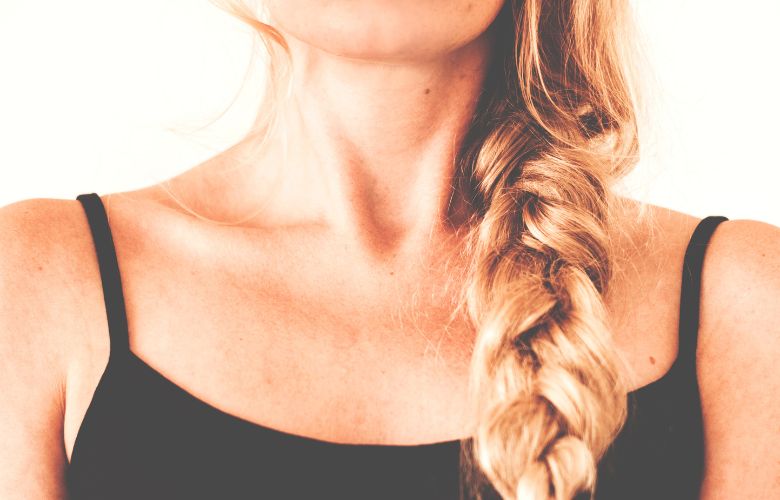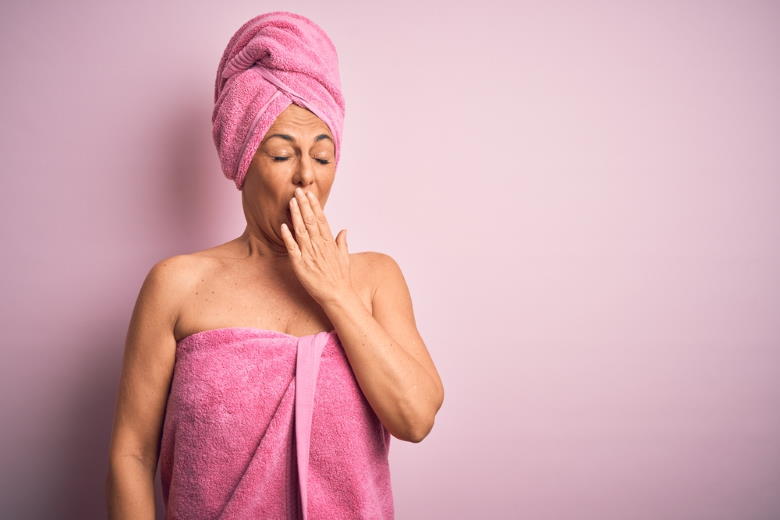I’m a night-showerer. I normally dry my hair fully but sometimes it’s late and I’m tired. So I go to bed with damp hair on occasion.
I’m happy to report that while it’s not recommended to sleep with wet hair (just like you shouldn’t sleep with your contacts in), it doesn’t have to be a total disaster in the morning if you take the right steps.
Tips For Sleeping With Wet Hair
Don’t Go To Bed With Dripping Wet Hair
In case this isn’t obvious, you don’t want to sleep on hair that’s totally wet. Not only is this bad for your hair health – because wet hair is more fragile than dry – but do you really want to sleep on a wet pillow and pillowcase?
At the very least, dry your hair enough so that it’s damp and no longer dripping.
You should also wash or change out your pillowcase more frequently if you go to sleep with damp hair.
Moisture is a breeding ground for bacteria and fungi. Mixed with the skin cells that naturally shed from your scalp, it’s a potent mix for skin irritation and infection if you lay on the same pillowcase night after night without laundering often.
Blow Dry on High For A Couple Minutes

I wouldn’t normally recommend using the high setting on your hair dryer if you’re planning to fully dry, but in this case, you want the high setting with heat to remove as much moisture as possible in a couple minutes.
It helps if you flip your head down and blow dry the bottom layer of hair too. This way you’re drying all around your head and getting your scalp dry before turning in.
Put Your Hair In A Bun
One girl I met at sleepaway camp when I was growing up used to put her hair up in a high bun every night before bed.
She did it to create volume in her very fine hair, and when she let it down the next morning, she had beautiful waves that looked great.
It’s also a great way for sleeping with damp hair if you have long hair.
Use a scrunchie to hold the bun in place, or a hair tie that isn’t too tight.
Or Braid Your Hair

If you have shorter hair, braid it in a loose french or traditional braid. Whatever method you choose, make sure it’s comfortable for you to sleep on.
You don’t want to wake up with a headache from sleeping on a thick braid in the wrong place.
And don’t worry about making the perfect braid. An imperfect, loose braid will give you a natural-looking wave the next day for some movement and volume.
Use A Satin Pillowcase
A satin pillowcase is a must for those sleeping with damp hair since it allows your hair to glide smoothly when you turn your head on it.
The fabric generates less friction so it also provides extra protection against tangles and frizz. It’s also nice and cool, which is a plus if you tend to get warm under the covers.
Wrap Hair With A Silk Hair Scarf
Alternatively, you can choose to sleep with a silk hair scarf wrapped around your head.
This is a good option if you don’t want to invest in a whole new satin pillowcase set.
Like the satin pillowcase, a silk scarf will also help prevent rubbing friction, leaving your hair intact in the morning.
Should You Wash Your Hair Before Bed?

I can only speak from my experience but I definitely prefer washing my hair at night because I like having a clean head on my pillow!
Washing your hair before bed helps remove any dirt and oil from the day’s activities.
It also helps ensure that you don’t wake up with dirty, brittle hair because of all the moisture that seeps away while you sleep.
However, there are times when washing your hair before bed might actually cause problems.
If you have oily hair, washing it before bed could lead to increased oil production over time, especially if you take hot showers every night.
If this is the case for you, try not to take a shower so close to bedtime, and rinse your hair with cool water before stepping out of the shower.
How Can I Avoid Frizz In The Morning?
One of the biggest problems with going to bed with wet hair is the inevitable frizz-fest you wake up with the next morning.
To combat this, try spritzing a leave-in conditioner on towel-dried hair and gently combing it through to spread it evenly.
This will help keep frizz to a minimum while also giving you some volume, shine, and softness.
Alternatively, you can also apply a serum if you have curly hair, which is generally more fragile than straight tresses.
A deep conditioning hair mask is another option if you suffer from seriously dry, frizztastic locks. It penetrates deeper than a standard leave-in conditioner to hydrate and repair, so it’s great for colored or chemically-processed hair.
Final Thoughts
Well there we have it, gals. You can save yourself from a tangled frizz-a-thon in the morning even after sleeping on damp hair.
Just don’t make a habit of it if you can help it – your hair will thank you.